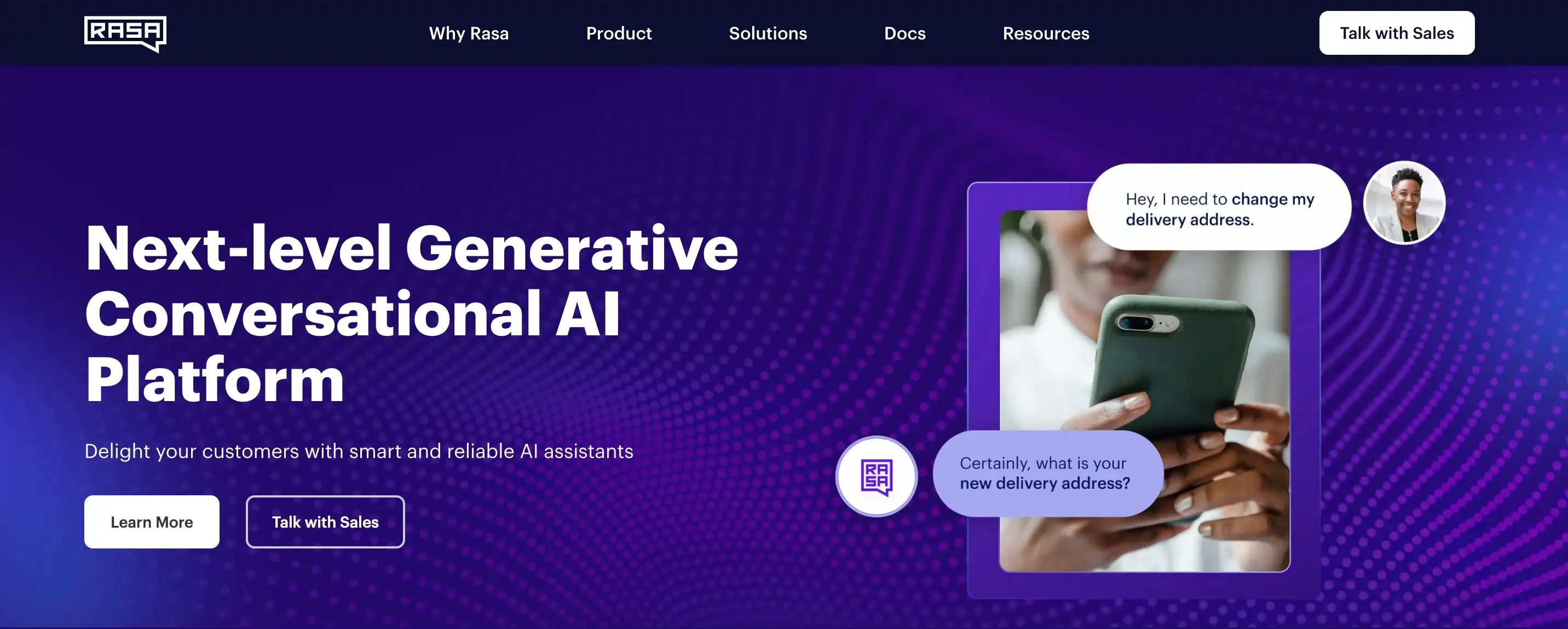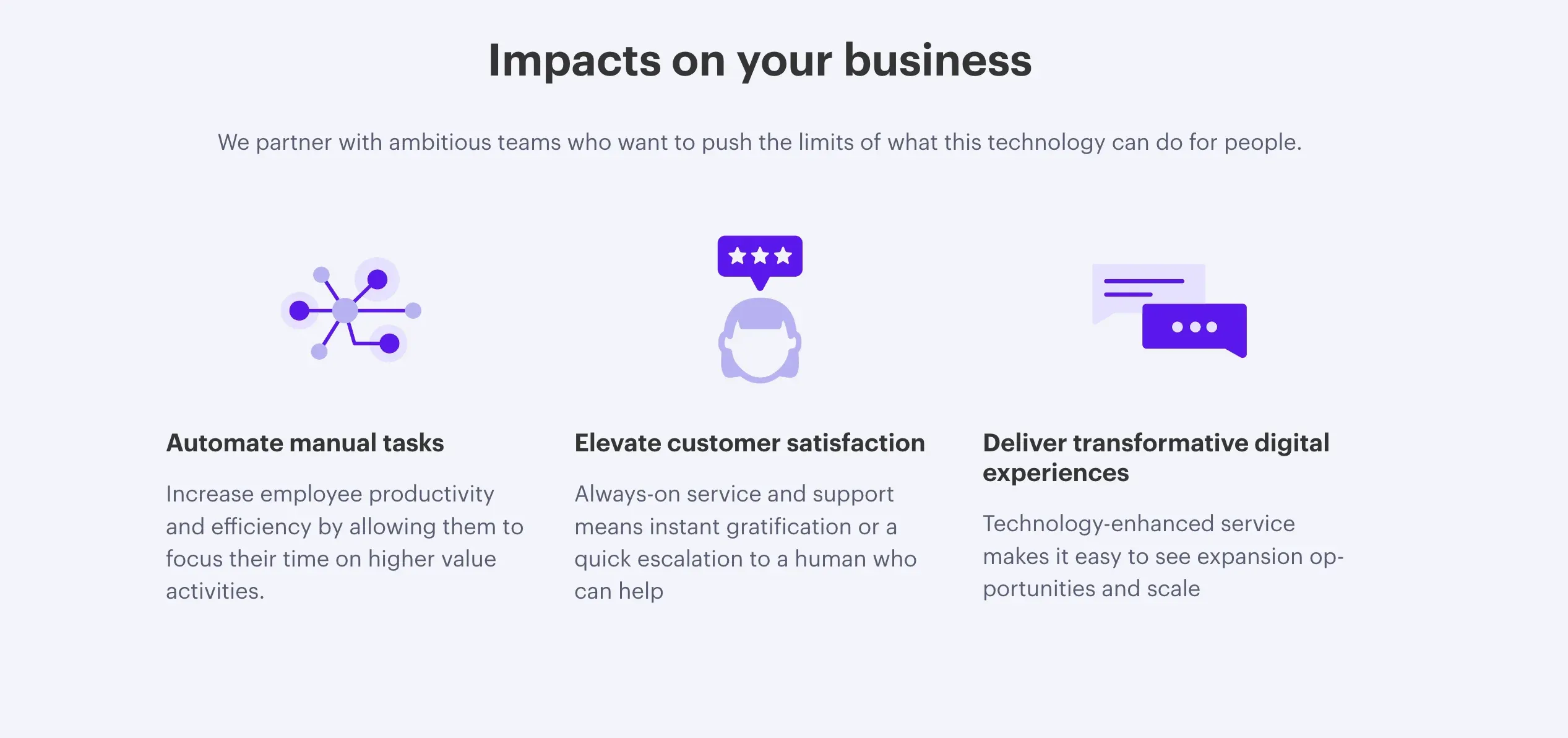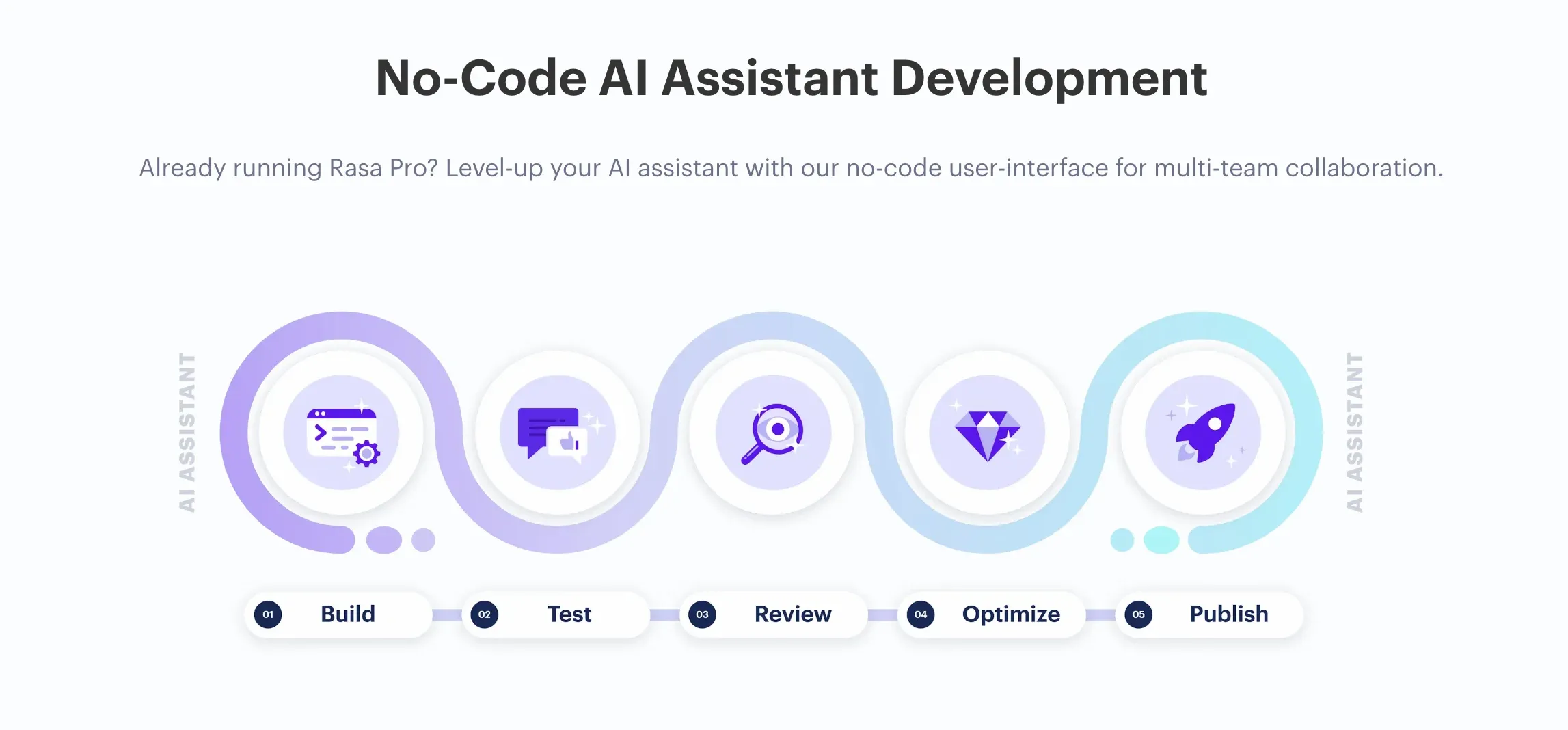Modern customers often need help with sifting through heaps of information. This leads to a disconnect that affects businesses' customer service quality.
Studies by NewVoiceMedia show that 68% of customers leave a company feeling unappreciated or indifferent to service.
But here's the game-changer: Rasa Technology. It's not just about chatbots; it's about building conversational assistants who can genuinely comprehend and respond accurately.
By leveraging advanced natural language processing and machine learning, Rasa enables businesses to build smarter chatbots. It truly understands and responds to customer needs.
Imagine chatbots answering questions, engaging in dynamic conversations, providing personalized recommendations, and predicting user intentions.
This blog delves into the core of Rasa's capabilities, empowering you to create chatbots that address pain points and foster meaningful customer relationships.
What is Rasa Technology?
Rasa is an open-source conversational AI platform that empowers developers to build, deploy, and refine AI-powered chatbots and virtual assistants.
It offers tools for developing natural language understanding (NLU) models and dialogue management systems, allowing for sophisticated and contextually aware user interactions.
Rasa's technology is built on machine learning and natural language processing (NLP) techniques. It enables developers to create AI models that understand and respond to user messages meaningfully and dynamically.
Understanding Rasa technology supports continuous learning, allowing chatbots to improve over time through user interactions and feedback.

Why Choose Rasa for Your Chatbot?
Choosing Rasa for your chatbot development offers a range of compelling advantages that set it apart as a top-tier platform.
Rasa empowers developers and businesses to create highly customizable and sophisticated chatbots that deliver exceptional user experiences.
Here are several compelling advantages:
Open-Source and Customizable
Rasa's open-source nature allows full customization. Tailor your chatbot's behavior to your requirements, ensuring it aligns perfectly with your business needs.
Full Control Over Data
With Rasa, you retain complete control over your data. This is particularly important for businesses with stringent data privacy and security requirements.
NLU and Dialogue Management
Rasa offers robust natural language understanding (NLU) and dialogue management capabilities. This ensures your chatbot can accurately comprehend user intents and engage in dynamic conversations.
Continuous Learning
Rasa enables your chatbot to learn and improve over time. It refines its responses as it interacts with users, enhancing user satisfaction and interaction quality.
Industry-Specific Chatbots
Rasa's flexibility makes it ideal for crafting industry-specific chatbots. Whether you're in healthcare, finance, or e-commerce, Rasa can be tailored to your industry's unique language and requirements.

Omni-Channel Deployment
Deploy your Rasa-powered chatbot across multiple channels – from websites to messaging apps. This widens your reach and ensures seamless user experiences.
Community and Support
Rasa boasts a thriving community of developers and users. This collaborative environment means you can find solutions, share ideas, and access resources easily.
Cost-Effective Solution
As an open-source platform, Rasa eliminates licensing fees. This makes it a cost-effective solution for businesses seeking advanced chatbot capabilities.
Scalability
Rasa's architecture is designed for scalability. It can handle increasing interactions and grow your business.
Future-Proofing
Rasa's focus on staying at the forefront of conversational AI ensures your chatbot remains up-to-date with the latest advancements in the field.
Suggested Reading
How Rasa Chatbots Work?
Rasa chatbots operate through a sophisticated process. It involves natural language understanding (NLU), dialogue management, and natural language generation (NLG).
Understanding Rasa NLU
The chatbot first processes user inputs using NLU models to comprehend intents, entities, and context. NLU translates user messages into structured data that the chatbot can understand, enabling it to identify users' wants.
Dialogue Management
Rasa's dialogue management component orchestrates conversations.
It employs a rule-based or machine learning-driven approach to determine the chatbot's response based on the current conversation context and user intent.
This allows the chatbot to navigate multi-turn interactions seamlessly.
NLG
Once the appropriate response is determined, the NLG component generates natural language responses that sound human-like and contextually relevant.
Training and Learning
Rasa chatbots continuously learn from interactions. Developers provide training data, and the chatbot's machine-learning models improve over time, refining the understanding of user intents and responses.
Integration
Rasa chatbots can be integrated across platforms and channels. They communicate with users through websites, messaging apps, and other platforms, ensuring a seamless and consistent experience.

Real-World Examples of Rasa NLU
1. Duolingo: This popular language learning app utilizes Rasa NLU to understand user utterances and guide them through personalized learning journeys.
It interprets user responses to questions, recognizes typos and slang, and adapts the difficulty level accordingly.
2. Zalando: This European online fashion retailer leveraged Rasa NLU to power its chatbot "Zalon."
Zalon understands user requests for specific clothing items, interprets size and style preferences, and suggests personalized recommendations using product information and user purchase history.
3. Commerzbank: This German bank implemented Rasa NLU in its virtual assistant "Finanzberater Chat."
The chatbot understands user questions about bank accounts, transactions, and financial products, providing answers and handling simple tasks like account balance inquiries.
4. The Washington Post: This major news organization uses Rasa NLU to power its "Heliograf" bot, which interacts with readers on Facebook Messenger.
Heliograf understands questions about articles, provides summaries, and recommends related content based on user interests.
5. HubSpot: This marketing and sales software company uses Rasa NLU in its "Live Chat Chatbot" tool.
The chatbot assists website visitors with basic questions, qualifies leads, and directs them to appropriate sales representatives, improving conversions and reducing customer support workload.
These are just a few examples of how Rasa NLU is used in real-world applications.
Its versatility allows it to be integrated into diverse platforms and industries, offering personalized user experiences and improving efficiency across various tasks.
Getting Started with Rasa
Getting started with Rasa involves several key steps to lay a strong foundation for your journey into the world of conversational AI.
Here's a concise guide to kickstart your Rasa experience:
- Installation: Begin by installing Rasa Open Source, the core framework for building chatbots. Rasa provides comprehensive installation guides for different platforms.
- Rasa Documentation: Familiarize yourself with Rasa's extensive documentation. It's a valuable resource for understanding concepts, best practices, and technical details.
- Create a Rasa Project: Initiate a new one using the command-line interface. This sets up the directory structure and essential files for your chatbot.
- Define Intents and Entities: Identify user intents (what users want) and entities (specific information within user messages). Create training data that maps intents to user phrases and extracts entities.
- Train Your Model: Use Rasa's training command to process your training data and train a machine-learning model. This model will be the brain behind your chatbot's understanding.
- Develop Stories: Craft dialogue flows using stories. Stories outline different paths users might take in conversations and help the chatbot respond appropriately.
- Responses and Actions: Define your chatbot's responses for different user intents. Create custom actions to perform tasks like calling APIs or querying databases.
- Testing: Test your chatbot using interactive sessions or the command-line interface. Refine your training data and dialogue flows based on test results
- NLU Tuning: Improve your chatbot's understanding by fine-tuning the NLU component. Add more training data and evaluate model performance.
- Dialogue Management: Enhance your chatbot's responses by incorporating dialogue management. Use Rasa's policy configurations to determine the best responses based on context.
- Integration: Integrate your Rasa chatbot with platforms such as websites, messaging apps, or voice assistants using Rasa's connectors.
- Deployment: Deploy your Rasa chatbot to the desired platform. Rasa offers guidance on deploying to cloud services, on-premise servers, and more
- Continuous Improvement: Regularly monitor and analyze your chatbot's performance. Use real user interactions to refine your model and make it more effective.
Remember, Rasa's community and documentation are valuable resources as you navigate each step.
With patience and practice, you'll soon harness the power of Rasa to create sophisticated and user-friendly chatbots.
Designing Intelligent Conversations
Creating intelligent conversations with chatbots requires a strategic approach combining user understanding, dynamic responses, and continuous refinement.
Here's how to master the art of creating engaging dialogues:
User-Centric Intent Recognition
Gain a deep understanding of user intentions within the conversation.
This foundational insight enables you to deliver responses that directly address their needs and queries, fostering meaningful interactions that resonate.
Dynamic Response Generation
Craft responses that seamlessly adapt to the evolving flow of the conversation.
By mirroring the fluidity of human discourse, you create a more natural and engaging dialogue, capturing users' attention and fostering genuine engagement.
Personalization and Context
Infuse a personalized touch using user-specific information and recalling context from previous interactions.
This demonstrates an understanding of individual preferences and enhances the overall user experience, making interactions feel more individualized and relatable.

Iterative Improvement
Embrace a culture of continuous improvement by analyzing user interactions and feedback.
This iterative approach allows your chatbot to learn from its interactions, identifying patterns and refining responses over time, ultimately ensuring a consistently elevated user experience.
Ethical Framework
Craft conversations that are both technologically advanced and ethically sound. Prioritize user privacy, avoid response biases, and uphold a transparent and fair approach.
This ethical foundation builds trust and credibility with users, laying the groundwork for enduring positive relationships.
Conclusion
Rasa is an open-source framework that can be used to build powerful and versatile chatbots.
To learn more about Rasa, visit the Rasa website or join the Rasa community.
It uses a combination of natural language understanding (NLU) and dialogue management to power its chatbots.
NLU is responsible for understanding the meaning of user input, while dialogue management is responsible for determining how the chatbot should respond. Rasa is a flexible framework used to build chatbots for various purposes, including customer service, sales, and education.
Rasa is also easy to use and maintain, making it a good choice for businesses of all sizes.
Rasa is a powerful tool that can be used to create truly helpful and engaging chatbots. Using Rasa, businesses can provide customers with a better experience and improve their bottom line.
If you want to build a smarter chatbot, Rasa is a great place to start.
We covered the basics of Rasa, including its NLU and dialogue management components. We also discussed the benefits of using Rasa and how to get started.
Businesses of all sizes who want to automate their customer service, sales, and marketing tasks, need more time and resources to build and maintain their chatbots.
BotPenguin is a free AI chatbot creator that anyone can use, even if they need coding experience.
Your businesses will save time and money, improve customer satisfaction, and increase sales.
Try it today and see how it can help you save time, and money, and improve your bottom line.
Frequently Asked Questions (FAQs)
How does Rasa Technology make chatbots smarter?
Rasa uses NLU for understanding and Core for dialogue to create seamless, intelligent chatbots.
Can I customize a Rasa chatbot's personality?
Rasa lets you tailor your chatbot's personality to match your brand's unique voice.
How flexible is Rasa for chatbot design?
Rasa is highly flexible, accommodating various chatbot designs and interactions.
What are "stories" in Rasa?
Stories in Rasa are scripts guiding chatbot interactions, ensuring engaging conversations.
How do forms improve Rasa chatbot conversations?
Forms structure conversations, guiding users through questions for smoother interactions.
Do Rasa chatbots learn and improve over time?
Yes, Rasa chatbots learn with each interaction, becoming more accurate and relevant.
How does Rasa handle multi-turn conversations?
Rasa Core manages multi-turn conversations, mimicking natural dialogue flow.
What do custom actions do in Rasa?
Custom actions enable chatbots to perform specific tasks beyond standard responses.


